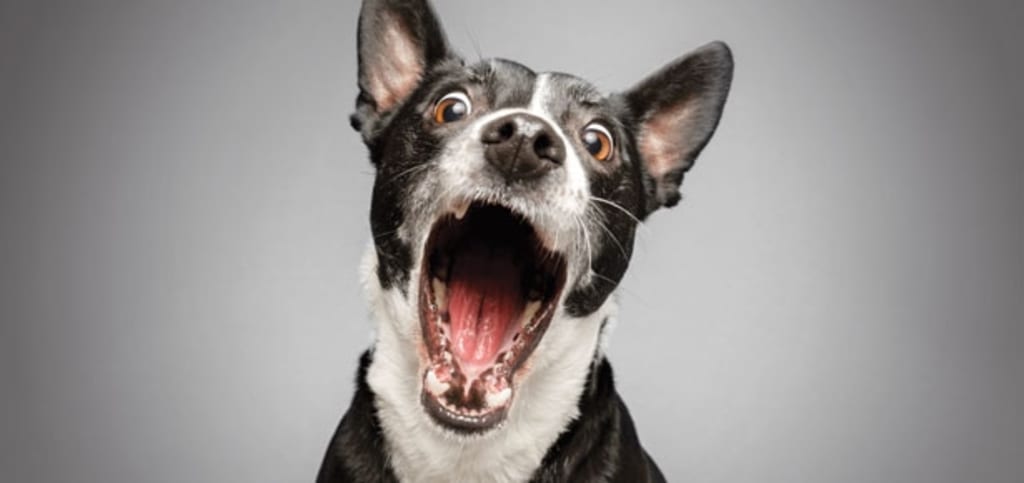How to Calm an Overly Excited Dog
Restore calm with this one easy-to-teach cue

"Out of the blue, he begins dashing around like an insane canine!"
"The children need to play with her, yet she gets so energized she won't quit nipping!"
"She continues to bounce on everybody and apparently can't quiet down!!"
Does any of this sound natural? As a mentor, I hear these sorts of remarks from pup proprietors, yet from proprietors of juvenile and grown-up canines too. To comprehend how to quiet an excessively invigorated canine, we initially should comprehend the reason why the canine is acting how he is.
Is it simply the "zoomies?"
In the first place, there are the "zoomies." With my past canines, we used to laughingly allude to those unexpected explosions of energy as the "lounge chair races" in light of the fact that our canines would out of nowhere begin hustling in circles around and around the family room love seat. Your canine could accomplish something almost identical, maybe tearing around aimlessly in your yard like he's pursuing an imperceptible rabbit. In all honesty, that is totally typical way of behaving! It's in your canine's actual DNA, truth be told. Canines and wolves are firmly related hereditarily. Wolves are crepuscular, meaning they are generally dynamic at first light and sunset. That is the point at which they would be out hunting, and it is the explanation your canine's zoomies regularly occur around sunrise and nightfall. In the event that your canine gets the zoomies, let him have at it! Throw a ball, pursue him around, or simply urge him to continue to go crazy all alone. It's a completely innocuous way for him to exhaust energy, and he'll be all the more quiet for it a short time later.
Play the "freeze!" game
Talking about playing with your canine, is that when he typically gets excessively stirred? While he's dashing near, his framework is being overwhelmed with adrenalin and other pressure synthetic substances. Assuming that he needs discretion, that beyond absurd excitement could appear as bouncing, nipping, or on the other hand, in the event that you have small kids, in any event, wrecking them. An incredible method for addressing this is to show your canine the "Freeze!" game. I will accept here that your canine knows Sit. To get your canine to "freeze," start by collapsing your arms and afterward promptly requesting that your canine sit. Rehash various times and, in the event that you have small kids, request that they do it also. Your canine will before long guess that collapsed arms mean he ought to sit. When your canine answers quickly to collapsed arms by sitting even without the verbal prompt "sit," now is the right time to play the game.
This is the way to show your canine this way of behaving:
Suppose you have two children. With everybody having treats helpful, start strolling around leisurely a good ways off from one another. Almost certainly your canine will begin strolling around too, needing to be important for the game. At the point when you see that your canine is almost one of the children, say, "Freeze!" When you do, everybody ought to quickly quit strolling, overlap their arms, stop. Whoever the canine is nearest to ought to confront the canine and request a Sit. When he does, a treat ought to be given, and the game proceeds. As you go, expecting your canine is getting along admirably, the activity ought to get an ever increasing number of energizing, traveling through rounds of increasingly fast strolling, stirring up to running, shouting, waving arms, or anything your children need to do.
On the off chance that he needs restraint, that beyond preposterous energy could appear as hopping, nipping, or on the other hand, assuming you have small kids, in any event, wrecking them.
With training, your canine will discover that anybody halting and collapsing arms implies he ought to quickly stop what he's doing and sit. Presently, when your children are playing and your canine beginnings getting excessively excited, pursuing them, bouncing and nipping, anybody can holler, "Freeze!" and everybody will freeze completely still and crease arms, and your canine will naturally sit. This exercise is great for enabling children, showing your canine discretion, and placing a break in the activity so it doesn't continue to raise uncontrolled. It is additionally useful for when your canine leaps on your children, as they can overlay their arms to get your canine to pause and sit.
Is the manner in which you're petting your canine setting off over-energy? It's surprisingly normal!
Something else that can get a canine excessively invigorated, in all honesty, is straightforward petting. I can't let you know how often I've heard somebody say, "He adores it when I pet him, however at that point he begins nipping!" The stunt is by they way you pet. Assuming you utilize long, quiet, delicate yet firm strokes and try not to descend over your canine's head, your canine ought to unwind. On the off chance that you pat, pat, pat, fiercely scratch, or generally pet your canine in a not exactly quiet manner, he will answer by ending up being energized and may try and think you are requesting play. Since he doesn't have opposable thumbs, he will rather utilize his mouth to answer. This happens particularly when canines are tapped over the head. In the event that your canine will in general get upset when pet, focus on the communication and attempt to bring your own energy down a couple of pegs.
Is an absence of activity the issue?
Ultimately, if your canine sems to be hyperactive overall as opposed to just in unambiguous circumstances, be certain he is getting sufficient activity. Contingent upon his age, breed, and state of being, he could require anything from a ten-minute stroll to a base mile-long climb to meet his actual necessities and in this manner act all the more serenely at home. (Most young canines waste time near sufficient activity.)
Be certain, as well, to give a lot of mental excitement as:
Bite things, for example, stuffed Kongs or menace sticks
Puzzles where he needs to move things to will treats (consistently manage)
Instructional courses, particularly clicker preparing, which helps canines to have an independent perspective and proposition ways of behaving.
About the Creator
Enjoyed the story? Support the Creator.
Subscribe for free to receive all their stories in your feed. You could also pledge your support or give them a one-off tip, letting them know you appreciate their work.






Comments
There are no comments for this story
Be the first to respond and start the conversation.